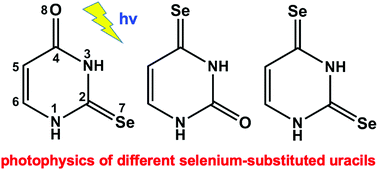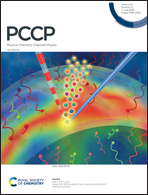Selenium substitution effects on excited-state properties and photophysics of uracil: a MS-CASPT2 study†
Abstract
The photophysics of selenium-substituted nucleobases has attracted recent experimental attention because they could serve as potential photosensitizers in photodynamic therapy. Herein, we present a comprehensive MS-CASPT2 study on the spectroscopic and excited-state properties, and photophysics of 2-selenouracil (2SeU), 4-selenouracil (4SeU), and 2,4-selenouracil (24SeU). Relevant minima, conical intersections, crossing points, and excited-state relaxation paths in the lowest five electronic states (i.e., S0, S1, S2, T2, and T1) are explored. On the basis of these results, their photophysical mechanisms are proposed. Upon photoirradiation to the bright S2 state, 2SeU quickly relaxes to its S2 minimum and then moves in an essentially barrierless way to a nearby S2/S1 conical intersection near which the S1 state is populated. Next, the S1 system arrives at an S1/T2/T1 intersection where a large S1/T1 spin–orbit coupling of 430.8 cm−1 makes the T1 state populated. In this state, a barrier of 6.8 kcal mol−1 will trap 2SeU for a while. In parallel, for 4SeU or 24SeU, the system first relaxes to the S2 minimum and then overcomes a small barrier to approach an S2/S1 conical intersection. Once hopping to the S1 state, there exists an extended region with very close S1, T2, and T1 energies. Similarly, a large S1/T1 spin–orbit coupling of 426.8 cm−1 drives the S1 → T1 intersystem crossing process thereby making the T1 state populated. Similarly, an energy barrier heavily suppresses electronic transition to the S0 state. The present work manifests that different selenium substitutions on uracil can lead to a certain extent of different vertical and adiabatic excitation energies, excited-state properties, and relaxation pathways. These insights could help understand the photophysics of selenium-substituted nucleobases.



 Please wait while we load your content...
Please wait while we load your content...